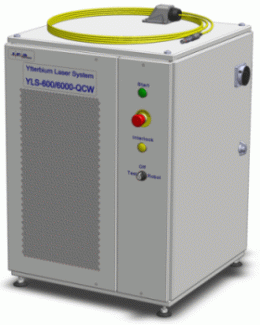Laser vendors stay cautiously optimistic 24 Oct 2012 Longbow Research finds industrial demand staying positive and fiber lasers gaining market share in the third quarter of 2012.

Big business: QCW sources from IPG The regular quarterly survey of industrial lasers and optics vendors undertaken by Longbow Research found that the mood remained modestly positive, even though the number of US vendors reporting an actual year-on-year increase in demand fell from 63 percent in Q2 2012 to 50 percent in Q3.
The number of respondents experiencing a fall in demand rose from 11 percent to 19 percent for the same periods.
Summarizing the results of the survey, Mark Douglass of Longbow indicated that demand within the automotive sector remained strong for all varieties of laser system, from low- to high-power. Continued investment in agricultural equipment was likewise supporting that sector, although flatter growth in 2013 seems likely.
Low-power marking applications also remained healthy, as the number of laser-marked parts in automobiles increases, and an FDA mandate to mark medical devices with unique ID information feeds through in that sector.
"The outlook remains cautiously optimistic," concluded Douglass. "Expectations deteriorated modestly in the US, though vendors in general still expect mid-single-digit growth, similar to the second quarter. International respondents were also more optimistic than not."
IPG stays dominant
One area of constant market activity remains, as ever, the fiber laser sector, where Longbow found that acceptance of fiber laser systems into 2D cutting applications was proceeding faster than most had expected, displacing CO2 and other solid-state lasers.
IPG Photonics remains the dominant force in fiber lasers, especially in high-power cutting applications. Other vendors were making only a modest impression.
"At present, it seems only some smaller OEMs are concerned and opting for Trumpf's SPI subsidiary as a second-source supplier, although I think more OEMs are talking about it," Douglass told Optics.org. "But for now there is little meaningful impact, since the larger OEMs are sticking with IPG because of its pricing power and quick turnaround on delivery."
Another weapon in the IPG arsenal is its medium-power quasi-CW (QCW) fiber lasers, positioned as replacements for existing lamp-pumped YAG lasers when users look to upgrade their tools. IPG has highlighted this as an area with the potential for major sales growth, and Longbow found enthusiasm for these sources among its survey respondents after trials in aerospace drilling applications.
"I think the turnover in the flashlamp Nd:YAG installed base is not a matter of 'if', but when and how rapidly it happens," commented Douglass. "It will be a long-term phenomenon before the installed base becomes mostly fiber lasers, perhaps three to five years, but it certainly should present incremental millions of dollars of annual opportunity in the near term, and probably tens of millions once the QCW sources are qualified. But how big of an opportunity is really hard to gauge."
Longbow also detected indications of a possible tie-up between IPG and Mitsubishi, a global OEM which does not at present offer a fiber laser option, but which might be gearing up to release IPG-equipped systems if rumors turn out to be correct.
"This would not necessarily be a game changer for IPG, since fiber and disk lasers are already gaining market share and getting attention," said Douglass. "But a Mitsubishi move, should it emerge, would certainly boost the prospects for more growth in 2013, against what we anticipate to be a flat to down market for capital equipment." Observers will await the important Fall trade shows, such as November's Fabtech, with interest.
International picture
Longbow's international survey found improved year-on-year activity in China, Germany and France, with the Chinese market seeing high-single-digit increases in demand after the relatively flat conditions of the previous quarter. China and the Eurozone were summarized as "weak, but not weakening further," by Longbow.
Global PMI, a broad indicator of economic health, rose from 48.1 in August to 48.9 in September, but was still well short of its recent high-point of 51.4 in April 2012.
Longbow also indicated that Nufern, the Rofin-Sinar subsidiary that specializes in fiber lasers, had made noticeable headway in Chinese markets despite not penetrating into domestic marking OEMs to the same extent.
"Emerging markets are more wide open and relationships not as well established," noted Douglass. "OEMs are critically important in the world of high-power flat sheet cutting, because users typically buy other metal fabrication machines from the OEMs, not just laser systems, and the space is fairly concentrated in a few hands. In marking and micromachining the importance of being levered to an OEM is less critical, as it is a more fragmented space."





